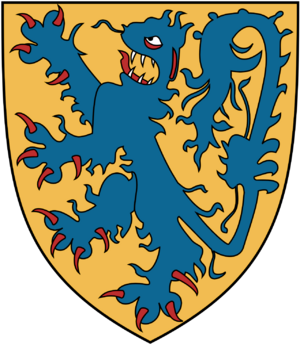Welf VI facts for kids
Quick facts for kids Welf VI |
|
|---|---|
 |
|
| Margrave of Tuscany | |
| Reign | 1152–1160 1167–1173 |
| Predecessor | Ulrich of Attems Welf VII |
| Successor | Welf VII Vacant |
| Duke of Spoleto | |
| Reign | 1152–1160 1167–1173 |
| Predecessor | Ulrich of Attems Welf VII |
| Successor | Welf VII Ridelulf |
| Born | 1115 |
| Died | 15 December 1191 (aged 75/76) |
| Spouse | Uta of Schauenburg |
| Issue | Welf VII Elisabeth |
| House | Welf |
| Father | Henry IX, Duke of Bavaria |
| Mother | Wulfhilde of Saxony |
Welf VI (born 1115, died 15 December 1191) was an important leader in the 12th century. He was a margrave (a type of ruler) of Tuscany and a duke of Spoleto in Italy. Welf VI was the third son of Henry IX, Duke of Bavaria, and belonged to the powerful Welf family.
Contents
Who Was Welf VI?
Welf VI was a member of the famous Welf family. He inherited lands in a region called Swabia (part of modern-day Germany). These lands included areas like Altdorf and Ravensburg. His older brother, Henry the Proud, received larger areas like Bavaria and Saxony. Welf married a woman named Uta. She was the daughter of Godfrey of Calw, who was a count palatine (a royal official) of the Rhine. After Godfrey died, Welf had a disagreement with Godfrey's nephew over who should inherit the lands of Calw.
Welf VI was also the uncle of a very famous ruler, Emperor Frederick Barbarossa. Barbarossa's mother, Judith, was Welf's sister. Even though Welf was Barbarossa's uncle, he was only about ten years older than his nephew. Most of Welf's important actions happened during Frederick Barbarossa's time as emperor.
Welf's Role in Conflicts and Peace
Welf VI was involved in several important events and conflicts during his lifetime.
Joining the Rebellion
In 1142, Conrad III of Germany, who was Frederick Barbarossa's uncle, took away the Duchy of Bavaria from Welf's family. Because of this, Welf joined his brother in a rebellion against Conrad III. Even though Welf and Conrad III had traveled together on the Second Crusade, Welf and his son, Welf VII, were later defeated. They lost a battle against Henry Berengar, who was Conrad III's son, at the Battle of Flochberg.
Making Peace and Gaining Lands
In 1152, the Welf family and another powerful family, the Hohenstaufen, decided to make peace. This was a big moment because Frederick Barbarossa was then chosen as king. In 1156, Barbarossa returned Bavaria to Henry the Lion, who was Henry the Proud's son.
In October 1152, at a place called Würzburg, Frederick Barbarossa gave Welf VI many important Italian lands. These included the duchy of Spoleto, the margraviate of Tuscany, and the principality of Sardinia. Welf received these lands because he was the head of his family at that time.
Feud with Hugh of Tübingen
Starting in the 1150s, Welf VI and his son, Welf VII, had a long-running disagreement with Hugh of Tübingen. Hugh was a count palatine in Swabia. This feud became very intense between 1164 and 1166. It finally ended when Emperor Frederick Barbarossa himself stepped in to settle the dispute. The emperor generally supported the Welf family in this conflict.
Later Life and Legacy
Welf VI faced a personal tragedy and made important decisions about his family's lands.
Loss of His Son
In 1167, Welf's only son, Welf VII, sadly died from a disease called malaria. This happened in Rome while Welf VII was on a military campaign with Emperor Barbarossa. They were fighting against Pope Alexander III. After his son's death, Henry the Lion (Welf's nephew) wanted to inherit all of Welf's family lands. Welf, however, asked for a large sum of money in return, which Henry could not pay. Because of this, Welf decided to give his Italian lands to the emperor instead. Welf continued to manage his Italian duchies until 1173. During this time, Christian, the Archbishop of Mainz, served as the emperor's representative.
Passing of Estates
Later, in 1176, a disagreement happened between Henry the Lion and Emperor Barbarossa during an Italian military campaign. This led to legal action against Henry in 1179, which resulted in him losing all his lands. This included the lands he had wanted to buy from Welf. These lands were given back to Welf VI. When Welf died in 1191, he gave these lands to Barbarossa's heir, the duke of Swabia. This meant that all the Welf family's lands in Swabia went to the Hohenstaufen family, who were related to Welf through his sister Judith. The main male line of the Welf family, descended from Henry the Lion, continued to rule their lands in northern Germany.
Welf VI was also a supporter of churches. He was buried in a monastery he helped create, called Steingaden Abbey in Bavaria. His son was also buried there. Welf was also the patron (a supporter) of the Historia Welforum, which was the first historical record of his family's story.
Welf VI's Children
Welf VI had at least two children with his wife, Uta:
- Elisabeth (born around 1135); she married Rudolf, Count of Pfullendorf.
- Welf VII (born around 1140, died 1167); he became the Duke of Spoleto and Margrave of Tuscany.


